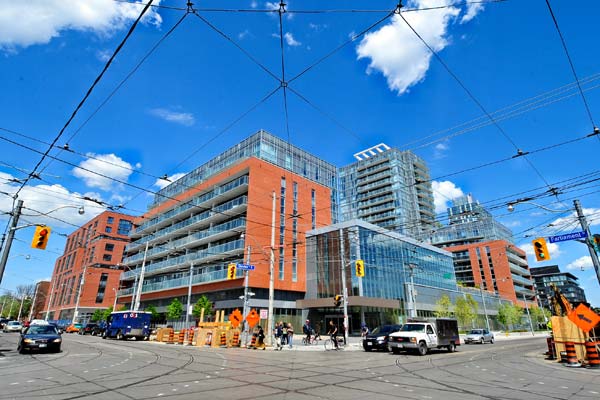
Regent Park residents sparked redevelopment, left with mixed feelings: urban studies undergrad research
Published: June 8, 2015
How much influence do residents have when it comes to a community’s redevelopment?
“City officials and planners seemed to want to hear the voices of residents,” said Sonia Sobrino Ralston, who pursued research on community involvement in the recent Regent Park revitalization with fellow urban studies undergraduate, Katerina Mizrokhi.
“But many residents stated that they felt alienated from the process,” she added.
The neighbourhood of Regent Park in downtown Toronto is home to Canada’s oldest and largest social housing project. Built in the late 1940s and early 1950s, the design was intended to improve the quality of housing and address crime and other social problems in the area. However, years of high crime rates and poor social conditions led to decades of physical and social decline, prompting Toronto Community Housing to launch a massive revitalization beginning in 2005 and continuing today.

The current renewal aims to transform the neighbourhood through a mix of rent-geared-to-income social housing units, affordable rental units, and privately owned condominiums. The physical redevelopment is occurring in tandem with efforts to integrate new and old residents into a more cohesive community. (Read more about the revitalization of Regent Park)
In order to understand the role of the community residents in the redevelopment, second-year students Ralston and Mizrokhi (pictured, left to right) combed through City of Toronto and Toronto Community Housing Corporation planning documents. They then conducted a series of interviews with some of the people involved.
In any neighbourhood development, knowing how best to consult and engage residents effectively can be a challenge.
To get a sense of what consultation had occurred and how, Ralston and Mizrokhi analyzed materials related to planning and social development in the neighbourhood. While they noticed a change in theme over time as political and financial concerns gave way to a greater emphasis on environmental and social sustainability, they also found a lack of transparency in official documents that made it difficult to determine what had actually occurred during the early stages of Regent Park’s renewal.
“It was difficult to tell from the documents how many meetings and consultations were held,” said Mizrokhi. “And it was unclear if the meetings that did take place focused on the development process or community engagement and leadership.”
Their interviews with city planners, developers, community leaders and residents drove home for both students how complex community engagement in development can be.
 “I began to see that although the redevelopment was met with challenges and dissenters, decisions were not made with malicious intent,” said Mizrokhi. “While interactions with residents showed a lot to be desired from the redevelopment, our interviews exposed the difficulties in navigating the bureaucratic nature of the organizations involved. I better understand the complications and challenges that occurred during the revitalization.”
“I began to see that although the redevelopment was met with challenges and dissenters, decisions were not made with malicious intent,” said Mizrokhi. “While interactions with residents showed a lot to be desired from the redevelopment, our interviews exposed the difficulties in navigating the bureaucratic nature of the organizations involved. I better understand the complications and challenges that occurred during the revitalization.”
Ralston notes the seeds of renewal were first sown by residents. (Image at right by samuel bietenholz via Flickr)
“Regent Park is unique because the revitalization was spurred by grassroots organizing on the part of residents in the early 1990s,” she said. “There appears to have been a strong attempt on the part of the City and Toronto Community Housing to solicit and respect residents’ wishes.”
Ralston and Mizrokhi worked with urban studies professor Shauna Brail as part of the Faculty of Arts & Science’s Research Opportunity Program.
“The work done by Sonia and Katerina significantly enhanced our understanding of how the redevelopment took shape,” said Brail. “The interviews in particular provided a far more nuanced understanding of the complexity of the revitalization than we had up to that point.”
Brail teaches a variety of urban studies courses leveraging hands-on experiences in Toronto. One of her fourth-year courses involving internships with urban organizations, as well as tours and analysis of key points in the city, is featured in the podcast below as students explore changes in the King and Spadina neighbourhood of Toronto.
(Click the down-pointing arrow button in the player to download the episode and transfer to your listening device. Transcript available here. Also available on iTunes and The Cities Podcast home)
For their part, Brail's second-year students say they learned the importance of diligence and detail in the course of research on Regent Park, but especially maintaining an unbiased approach.
“Had I only analyzed official documents and not attended community meetings and interviewed officials involved in the process, I would not have become as well-versed in the situation,” said Mizrokhi. “It’s made me a more analytical, critical and rational researcher.”



